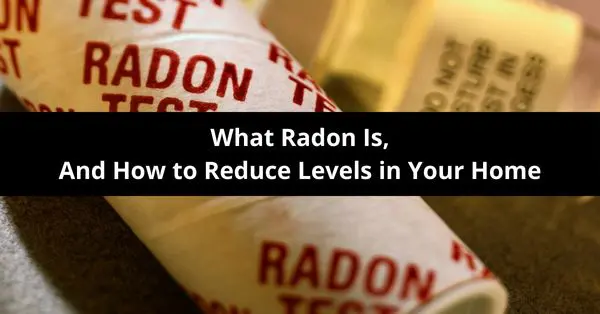Radon is a naturally occurring radioactive gas caused by the breakdown of uranium in soil, rock, and water. Outdoors, radon dilutes into the air, so it poses no harm to human health. Indoors, radon poses health risks and is the leading cause of lung cancer in people who don’t smoke.
Radon in your home can come from two sources, the soil or your water supply, and one in 15 homes in the United States have it. Any home can have radon regardless of its age or the materials it’s constructed from. Radon enters homes and gets trapped through foundation cracks, gaps around pipes, wires, pumps, small pores in hollow block walls, and drains. This is how it can be carried above the ground and into your home.
Because radon gas can’t be seen, smelled, or tasted, the only way to know whether your house has radon is to test for it.
How To Test For Radon
The only way to determine the level of radon testing in your home is an air test. Radon testing is a measure of how much radon is in the air vs. a lead test which tests surfaces for the presence of lead. Homeowners should test for radon after any renovations and every two years as part of routine home maintenance.
To test for radon, your options are a short term (2 – 90 days) test, a long term (90+ days) test, or have a professional radon specialist test. “Do-it-yourself” test kits can be purchased from hardware stores, online, and requests can be made through your local health department.
The EPA recommended level of radon is less than 4.0 pCi/L. If your home has a higher level, you have options.
What To Do If You Have A High Radon Level
If the levels of radon in your home are above 4.0 pCi/L, there are several radon mitigation methods you can use to reduce the radon levels in your home. The table below will help you find which options make sense for you to use to reduce the radon levels in your home. It is based on the type of foundation your home has, and radon reduction technique.
| Technique | Typical Radon Reduction* | Comments |
| Subslab Suction | 50% – 99% | Works best if air can move easily under the slab |
| Passive Subslab Suction | 30% – 70% | Not as effective as active subslab suction |
| Drain-tile Suction | 50% – 99% | Works with partial and complete drain tile loops |
| Block-wall Suction | 50% – 99% | Can only be used with hollow block walls and requires the sealing of major openings |
| Sump-hole Suction | 50% – 99% | Works best if air can move easily to the sump pump from under the slab |
| Submembrane Depressurization in a Crawlspace | 50% – 99% | Less heat loss than natural ventilation in cold winter climates |
| Natural Ventilation in a Crawlspace | 0% – 50% | Cost of this can be variable |
| Sealing | Varies | Normally only used with other techniques |
| House Pressurization | 50% – 99% | Works best with basements isolated from outdoors |
| Natural Ventilation | Varies | Significant heated or cooled air loss |
| Heat Recovery Ventilation | Varies | Effectiveness limited by radon concentration |
| Aeration | 95% – 99% | More efficient than GAC |
| Granular Activated Carbon (GAC) | 85% – 95% | Less efficient for higher levels than aeration |
*From https://www.epa.gov/radon
If you have a basement or slab-on-grade home foundation (a single layer of concrete several inches thick), radon levels can be reduced by using one of these four types of soil suction:
- Subslab (most popular)
- Drain-tile
- Sump-hole
- Block-wall
In a home with a crawl space, the most effective way to reduce radon levels is to use submembrane suction. With this method, the bare earth is covered with a high-density plastic sheet and a vent pipe and fan are then installed to draw the radon out from under the sheet. It is then vented outdoors. The main disadvantage of this method is that the crawl space has to be sealed from the rest of the home.
You can hire a qualified radon reduction contractor too. A professional knows which system will work best for your property, and to find one, you can search the National Radon Proficiency Program database, the National Radon Safety Board database, or ask your state’s radon office for recommendations.
If the water for your home comes from a private well with radon, you can use granular activated carbon (GAC) filters or aeration devices to remove it.
For granular activated carbon filters, a filter is installed outside of your home and uses activated carbon to remove the radon from the water. The biggest disadvantage of this technique is that these filters collect radioactive material and the longer it is installed, the more radioactive it can become. Disposing of these filters can require special equipment and professional help.
The most effective way to remove radon from your water are home aeration devices. Since radon is a gas, it can be removed from your water by blowing air through the water and allowing the dissolved radon gas to be collected and vented outside.
Once you’ve tried these radon lowering methods, test the air again to verify that your radon level is below 4.0 pCi/L.
Your last option if you have a radon problem is to sell your home if you don’t have the time or resources to pay for a radon mitigation system.
You can:
- Offer a credit for the cost of a mitigation system
- Sell your home as-is
- Sell your home for cash to companies like ours
While there are no federal laws requiring disclosure, many states have their own radon laws. Texas, DC and Ohio all require a radon disclosure when selling your home. Other states do not. A licensed real estate agent in your state will be able to help you learn if you are or are not required to disclose radon in your home when you sell it.
Your options if you have radon in your home are pretty straightforward now that you know what radon is and how to test for it. You’ll have the peace of mind that comes with knowing you’ve protected your family from the health effects of radon.


